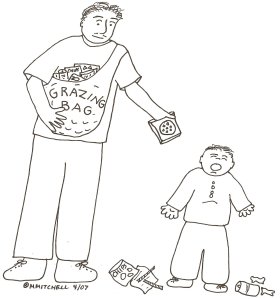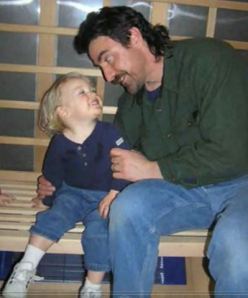By Patrick Mitchell
If some is good, more must be better. That’s the reasoning some parents employ when giving their kids snacks to keep them quiet, stop them from running around, or to distract them from just about anything.
Trouble is, too many snacks keep some kids underweight (because they’re not hungry for dinner), and piles on extra calories for children already eating plenty at the dinner table. I asked Bryan S. Vartabedian M.D., a pediatric gastroenterologist and pediatrician about it. He specializes in helping young children gain weight if they’re light or slim down if they’re heavy.
‘The Grazing Canister’
Dr. Vartabedian, attending physician at Texas Children’s Health Center and assistant professor of pediatrics at Baylor College of Medicine, described a typical day at the office: “A toddler is brought in for evaluation. During the course of our visit, any type of whining, fussing, or protest triggers the appearance of the grazing canister from mom’s bag. Grazing canisters are those small, colorful plastic snack containers that are suited for the fast, easy delivery of refined carbohydrates anytime, anywhere. And then, hand-to-mouth, the fish-shaped crackers or bear-shaped graham crackers disappear as fast as they appeared…. In pediatrics we call it grazing when kids are continually eating. It kind of wreaks havoc with their blood sugar. And when it comes time to eat, they really don’t have the metabolic drive to eat at mealtime,” he said. “It’s like putting the mule bag on the mule.”
Some kids who over-snack aren’t hungry for dinner, and that can cause problems. “One of my most common referrals is the child who is not eating or not gaining weight, say, a two year old who’s below the fifth-percentile and the pediatrician has referred them to me to help determine what’s going on. He said parent education plays a big role. “The vast majority are preventable by parent education.”
Parents who mean well mistakenly “haul out the grazing bag” almost unconsciously because they’ve learned that giving their child food preoccupies the child quite well, Dr. Vartebedian told me. After all, he explained, you can’t scream too loudly with food in your mouth, and most kids will stop running around when offered a snack. He says most parents perceive the ‘grazing bag’ as innocent, but it’s not. “Allowing children to graze represents a breakdown in feeding discipline. As a general rule, we tend to placate our kids with food. And we see it all around us—at airports, supermarkets, wherever. Parents are going for ‘peace at any price.’ They’re opening that grazing canister in exchange for peace and quiet,” he said.
Handing out the feed bag he said “rewards marginal behavior,” he said. “It reinforces that we deal with boredom and other emotions with food. Unless it is a designated snack time, it isn’t consistent with good feeding structure.”
‘Twinkies Can’t Fly’
Dr. Vartabedian said parents need to set the stage for proper eating. “We have to create the proper environment for eating for our kids. That kind of goes back to that issue of modeling for our children. What we do is oftentimes what our children will do. What we feed ourselves is oftentimes what our children will learn to feed themselves. So, when we create an environment where we, as parents, are really eating better on our own, we’re modeling for our kids,” he said. Food choices that parents make in the grocery store, while their kids are watching, are important, he said. “I often say that ‘Twinkies can’t fly.’ They can’t jump into the shopping cart alone. The point is this: if we bring chips and junk food into the house and all this stuff is available, then that becomes our eating pattern. I think it’s very hard. I’ll tell you, for me it’s very, very hard to discipline myself to eating right. Your kids are watching. They look up to you,” he said.
Kids Need (Food) Structure
“Structure is very important. It’s funny, when you talk to parents about bedtime or bath time there’s a lot of rituals and routines around bathing kids and putting them to bed, because parents, for some reason, seem to understand that when it comes to sleep habits, rituals and patterns are very, very important. Now, when it comes to eating, the structure seems to fall apart. A lot of my patients (children) don’t recognize that structure has to be an important part of healthy eating,” he said. “Allowing a kid to go two or three hours or even more without having a snack or without having food from mid-afternoon to dinner is perfectly fine. Yeah, the kid may complain that they’re hungry, but that’s not a problem. That structure is going to lead them to a really solid dinner when dinnertime comes. So, I think that structure (with mealtime) is really important.”
The Doctor’s Recommendations
Asked for general feeding guidelines for the average preschool child, Dr. Vartabedian said this: “For a typical three year old, that would involve three solid meals a day—breakfast, lunch and dinner. That three-meal-a-day pattern typically begins around late in the first year of life, close to the first year of age. Three solid meals a day and two, perhaps three, snacks per day. A late morning, mid-afternoon, and perhaps an evening snack,” he said. As for the content of snacks, Dr. Vartabedian said this: “A snack should be seen as an opportunity to broaden the child’s horizons. Typically, with my own kids and my own patients, we recommend fruits and vegetables as snacks—sometimes offering a couple of options, such as cut grapes along with some crackers, giving the child a chance to try some new things. The way these foods are presented is very important as well. Fresh fruit is good, and things of that nature…. Offering cut grapes and cut celery, from a very early age, so the children only know how to do that.”
He Continued: “Now, for the child who has started on this at a late age, when you give them no other option, and you give them cut fruit or nothing….they’re going to take it. They may block it first, but they will take it. I’ve seen this with my own kids. They’ll protest for cookies and crackers. You cut the apple, you put it on the plate and walk away, and about ten minutes later they’re back for the apple. You can give them goldfish, but just introduce healthy options for the kids including fruits and vegetables,” he said.
Give Picky Preschool Eaters Space
“Very oftentimes, parents are preoccupied with what their children are doing, or not doing, with their food. The average eight-month old, given three meals a day, is going to consume about one-and-a-half of those meals. And that is a very normal feeding behavior. They’ll play with the rest, they’ll eat it, or they’re not interested in it. At that age, or certainly before the preschool years, a child’s drive to eat is purely driven by their metabolic need, and not by social forces. For example, around age five, children will start to eat because it’s dinnertime (or) they’ll eat to make mom or dad happy, they’ll eat because they’re going to get a reward, they’ll eat because of a social circumstance,” he said. “Prior to age four or so, kids are purely going to eat based upon what they need. That’s what drives us crazy as parents because we want them to meet our little agenda of eating big and eating healthy and all of that, but kids are driven by their own internal metabolism prior to the preschool years. The worst thing we can do is to fight or struggle with a child. The best thing is to pull back and give them space and realize that the child is not going to starve. And, when we recognize that a child has the capacity to take what they need on their own, we oftentimes have a lot more success than when we try to play a lot of games and try to do subtle force-feeding that we like to do,” he said.
“Make solid food choices for the whole family, because you cannot isolate a child in that household from the rest of the family. The child will eat the way the rest of the family is eating. There’s nothing wrong with goldfish (crackers). There are no bad foods, only bad diets and bad food choices. We don’t have to throw away the goldfish— we just want to put them into a balanced diet.”
A Special Role for Dads
Dads may play a special role in helping kids learn to eat well, says Dr. Vartabedian. Are all parents susceptible to this? “It depends on the dad, but some dads are quicker to open up the grazing canister because they don’t have the mechanisms in place to keep the kids in line. I’m a dad. My son is eight and my daughter is three. When you talk about discipline and modeling for kids, it’s so interesting that when I’m at home in the evening or anytime for that matter, and I grab a cracker before dinner, my kids, who were occupied with something else, see me eating and then immediately want to have something to eat themselves. In terms of the grazing behavior, we parents model that for our kids. Dads have to model for our children for the sake of their future health,” he said.
“Moms are definitely more preoccupied with all the bad things that can happen if their child doesn’t eat well. Fathers are less apt to be worried about a missed meal. In many respects, they’re more laid back, and more apt to leave kids alone, and more apt to do a better job at that space issue,” he said. “Dads are funny, because they are sometimes a little bit more laid back in their parenting style, and mothers are sometimes the ones that are a little bit more uptight. Interestingly, sometimes, when kids are left alone with their dads, who can sometimes be a little bit more playful, kids will sometimes do better. At dinnertime and other mealtimes, fathers interact with their children quite a bit differently than mothers do. Sometimes they’re often more playful and less serious, and sometimes when it comes to feeding, those are attributes that really work. So, dads may have something special to offer as far as feeding,” Dr. Vartabedian said.


